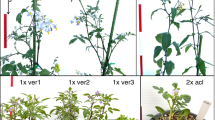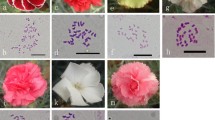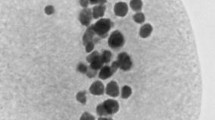Summary
Interspecific crosses of Hordeum brachyantherum (2n = 28) and H. depressum (2n = 28) with H. bulbosum (2n = 14 or 28) and H. vulgare (2n = 14 or 28) were made. Crosses between brachyantherum and diploid bulbosum resulted in dihaploids (2n = 14) of brachyantherum and hybrids (2n = 21), whilst the crosses of brachyantherum by tetraploid bulbosum or vulgare gave hybrid progeny. Similarly, crosses between H. depressum and diploid bulbosum resulted in dihaploids (2n = 14) of depressum and hybrids (2n = 21), whereas depressum by tetraploid bulbosum or vulgare invariably produced hybrids.
Cytological observations on 12 day old embryos obtained from these crosses revealed chromosome variability down to 14 in crosses with diploid bulbosum indicating thereby that chromosome elimination leads to haploid formation. Embryonic cells from the brachyantherum by diploid vulgare cross also exhibited a certain degree of chromosomal instability as micronuclei.
The results indicate that the ratio of parental genomes in the zygote determines whether haploids or hybrids will be produced in crosses of brachyantherum or depressum with bulbosum. Furthermore, brachyantherum appears to be more efficient in eliminating bulbosum chromosomes in comparison with depressum.
Similar content being viewed by others
Literature
Barclay, I.R.: High frequencies of haploid production in wheat (Triticum aestivum) by chromosome elimination. Nature 256, 410–411 (1975)
Barclay, I.R.; Sheperd, K.W.; Sparrow, D.H.: Chromosome elimination in Hordeum vulgare — Hordeum bulbosum hybrids. Biennial Report (1970–71) Waite Agric. Res. Inst. Univ. of Adelaide, S. Australia, 39–40 (1972)
Fedak, G.: Haploids from barley X rye crosses. Canad. J. Genet. Cytol. 19, 15–19 (1977)
Ho, K.M.; Kasha, K.J.: Genetic control of chromosome elimination during haploid formation in barley. Genetics 81, 263–275 (1975)
Kao, K.N.; Kasha, K.J.: Haploidy from interspecific crosses with tetraploid barley. Barley Genetics 2, 82–87 (1969)
Kasha, K.J.: Haploids in Higher Plants — Advances and Potential. Proc. of the First Internatl. Symp. June 10–14 1974, Univ. of Guelph 1974
Kasha, K.J.; Kao, K.N.: High frequency haploid production in barley (Hordeum vulgare L.) Nature 225, 874–876 (1970)
Kasha, K.J.; Reinbergs, E.; Johns, W.A.; Subrahmanyam, N.C.; Ho, K.M.: Barley Haploid Studies. Barley Genet. Newsl. 2, 36–41 (1972)
Kruse, A.: Intergeneric hybrids between Hordeum vulgare L. ssp. distichum (v. ‘Pallas’ 2n = 14) and Secale cereale L. (v. ‘Petkus’ 2n = 14) Kal. Vet. Landb. Arsskr. 82–92 (1967)
Lange, W.: Crosses between Hordeum vulgare L. and H. bulbosum L. 1. Production, morphology and meiosis of hybrids, haploids and dihaploids. Euphytica 20, 14–29 (1971a)
Lange, W.: Crosses between Hordeum vulgare L. and H. bulbosum L. 2. Elimination of chromosomes in hybrid tissues. Euphytica 20, 181–194 (1971b)
Orton, T.J.; Tai, W.: Chromosome elimination in a complex hybrid of the genus Hordeum. Canad. J. Bot. 55, 3023–3033 (1977)
Rajhathy, T.; Symko, S.: High frequency of haploids from crosses of Hordeum lechleri (6x) x H. vulgare (2x) and H. jubatum (4x) x H. bulbosum (2x). Canad. J. Genet. Cytol. 16 468–472 (1974)
Rajhathy, T.; Morrison, J.W.; Symko, S.: Interspecific and intergeneric hybrids in Hordeum. Barley Genetics 1, 195–213 (1963)
Shigenobu, T.; Sakamoto, S.: Production of a polyhaploid plant of Aegilops crassa (6x) pollinated by Hordeum bulbosum. Jap. J. Genet. 52, 397–401 (1977)
Starks, G.D.; Tai, W.: Genome analysis of Hordeum jubatum and H. compressum. Canad. J. Genet. Cytol. 16, 663–668 (1974)
Subrahmanyam, N.C.: Haploidy from Hordeum interspecific crosses. I. Polyhaploids of H. parodii and H. procerum. Theor. Appl. Genet. 49, 209–217 (1977)
Subrahmanyam, N.C.: Haploids and hybrids following interspecific crosses. Barley Genet. Newsl. 8, 97–99 (1978)
Subrahmanyam, N.C.; Kasha, K.J.: Selective chromosomal elimination during haploid formation in barley following interspecific hybridization. Chromosoma 42, 111–125 (1973a)
Subrahmanyam, N.C.; Kasha, K.J.: Feeding of detached tillers improves haploid formation in barley. Barley Genet. Newsl. 3, 68–71 (1973b)
Wagenaar, E.B.: The cytology of three hybrids involving Hordeum jubatum L. The chiasma distributions and the occurrence of pseudo ring-bivalents in genetically induced asynapsis. Canad. J. Bot. 38, 69–85 (1960)
Author information
Authors and Affiliations
Additional information
Communicated by F. Mechelke
Rights and permissions
About this article
Cite this article
Subrahmanyam, N.C. Haploidy from Hordeum interspecific crosses. Theoret. Appl. Genetics 55, 139–144 (1979). https://doi.org/10.1007/BF00295440
Received:
Issue Date:
DOI: https://doi.org/10.1007/BF00295440




